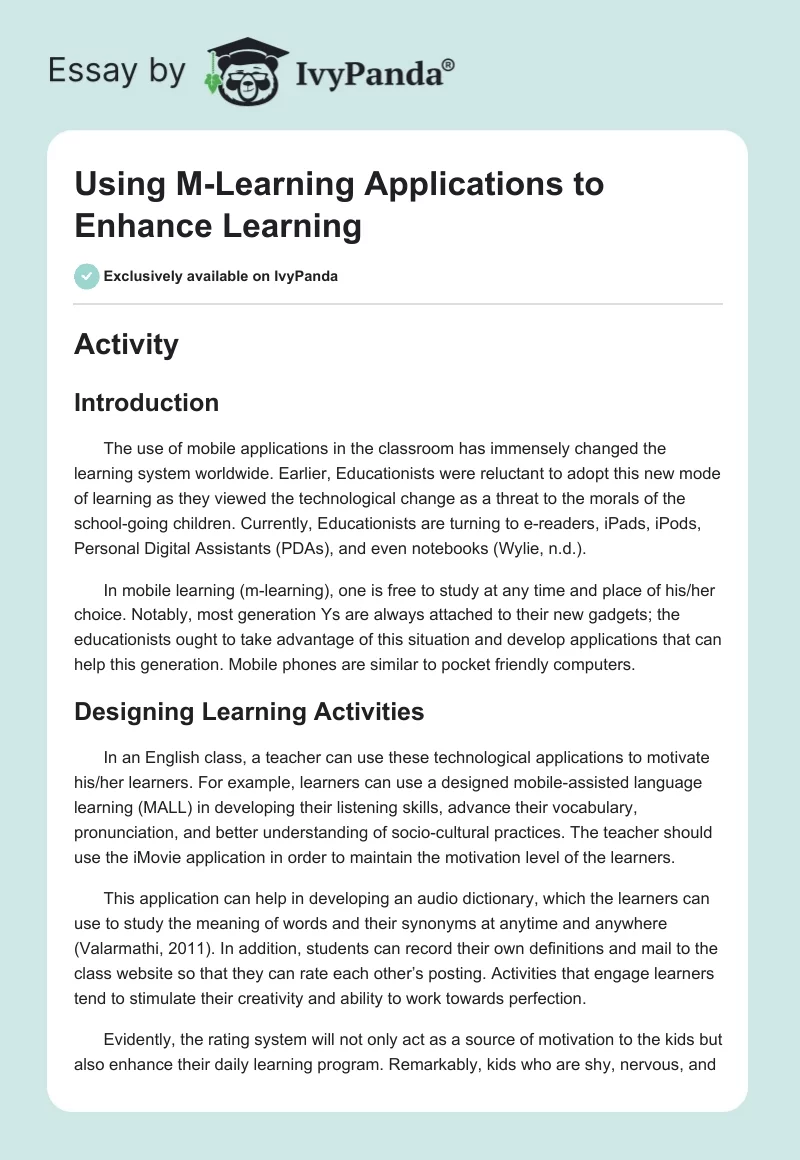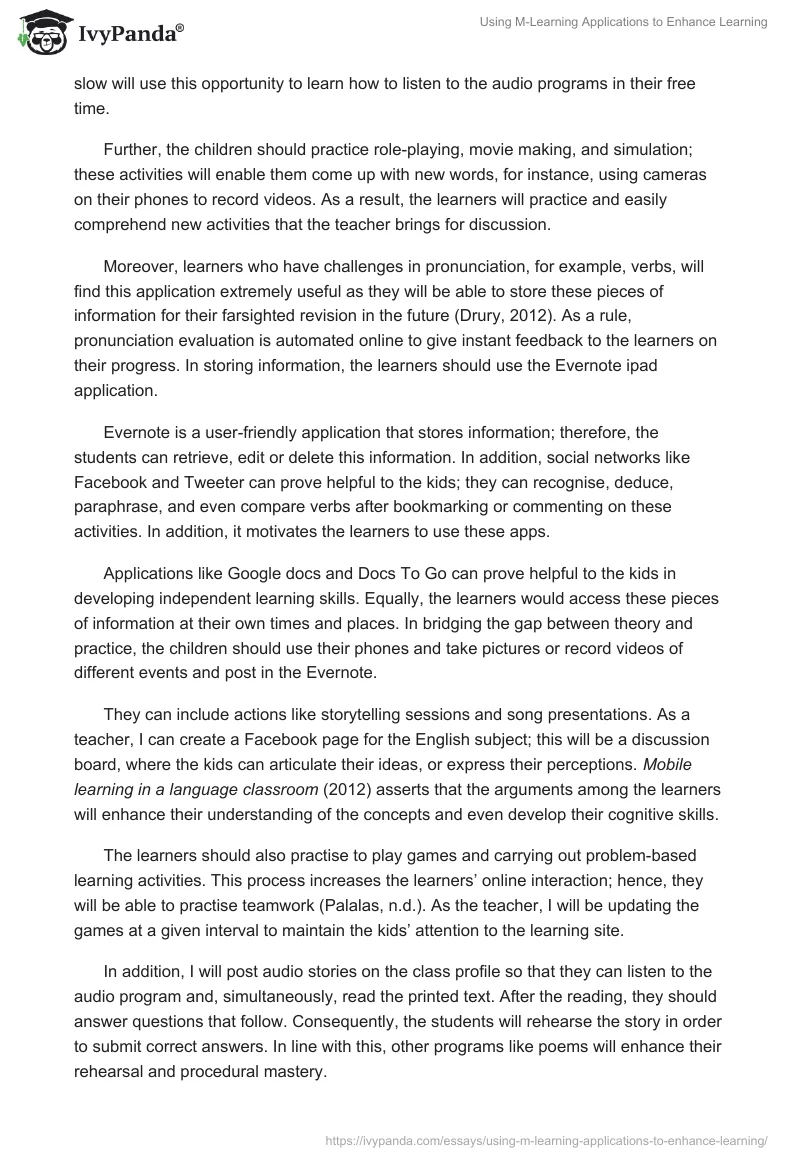Activity
Introduction
The use of mobile applications in the classroom has immensely changed the learning system worldwide. Earlier, Educationists were reluctant to adopt this new mode of learning as they viewed the technological change as a threat to the morals of the school-going children. Currently, Educationists are turning to e-readers, iPads, iPods, Personal Digital Assistants (PDAs), and even notebooks (Wylie, n.d.).
In mobile learning (m-learning), one is free to study at any time and place of his/her choice. Notably, most generation Ys are always attached to their new gadgets; the educationists ought to take advantage of this situation and develop applications that can help this generation. Mobile phones are similar to pocket friendly computers.
Designing Learning Activities
In an English class, a teacher can use these technological applications to motivate his/her learners. For example, learners can use a designed mobile-assisted language learning (MALL) in developing their listening skills, advance their vocabulary, pronunciation, and better understanding of socio-cultural practices. The teacher should use the iMovie application in order to maintain the motivation level of the learners.
This application can help in developing an audio dictionary, which the learners can use to study the meaning of words and their synonyms at anytime and anywhere (Valarmathi, 2011). In addition, students can record their own definitions and mail to the class website so that they can rate each other’s posting. Activities that engage learners tend to stimulate their creativity and ability to work towards perfection.
Evidently, the rating system will not only act as a source of motivation to the kids but also enhance their daily learning program. Remarkably, kids who are shy, nervous, and slow will use this opportunity to learn how to listen to the audio programs in their free time.
Further, the children should practice role-playing, movie making, and simulation; these activities will enable them come up with new words, for instance, using cameras on their phones to record videos. As a result, the learners will practice and easily comprehend new activities that the teacher brings for discussion.
Moreover, learners who have challenges in pronunciation, for example, verbs, will find this application extremely useful as they will be able to store these pieces of information for their farsighted revision in the future (Drury, 2012). As a rule, pronunciation evaluation is automated online to give instant feedback to the learners on their progress. In storing information, the learners should use the Evernote ipad application.
Evernote is a user-friendly application that stores information; therefore, the students can retrieve, edit or delete this information. In addition, social networks like Facebook and Tweeter can prove helpful to the kids; they can recognise, deduce, paraphrase, and even compare verbs after bookmarking or commenting on these activities. In addition, it motivates the learners to use these apps.
Applications like Google docs and Docs To Go can prove helpful to the kids in developing independent learning skills. Equally, the learners would access these pieces of information at their own times and places. In bridging the gap between theory and practice, the children should use their phones and take pictures or record videos of different events and post in the Evernote.
They can include actions like storytelling sessions and song presentations. As a teacher, I can create a Facebook page for the English subject; this will be a discussion board, where the kids can articulate their ideas, or express their perceptions. Mobile learning in a language classroom (2012) asserts that the arguments among the learners will enhance their understanding of the concepts and even develop their cognitive skills.
The learners should also practise to play games and carrying out problem-based learning activities. This process increases the learners’ online interaction; hence, they will be able to practise teamwork (Palalas, n.d.). As the teacher, I will be updating the games at a given interval to maintain the kids’ attention to the learning site.
In addition, I will post audio stories on the class profile so that they can listen to the audio program and, simultaneously, read the printed text. After the reading, they should answer questions that follow. Consequently, the students will rehearse the story in order to submit correct answers. In line with this, other programs like poems will enhance their rehearsal and procedural mastery.
Mobile Learning Strategy
Introduction
An effective mobile learning blueprint does not only demands for the knowledge of our intended destination but also how we will gauge our success (Garg, 2010). In considering a mobile learning strategy, I will evaluate the techno savvy ability in my audience/organization.
Notably, in the strategy, I will try to provide a cost friendly mobile application for learning. In addition, I will ensure that I inculcate the recent technological changes on the mobile industry. The app should also be user friendly so that members in the organization can quickly adjust to its operation mode.
Aiming at a specific device
In targeting the organization, I will devise a program that operates in most mobile devices because it is costly to incorporate all the gadgets in the program. On the other hand, the organization can supply a specific gadget to all members. This action will reduce the production cost since a specific mobile app will be able to operate in all the gadgets. It is also factual that not all devices that the trainees have are similar.
Design for Performance and Support
While training members of an organization on new issues at the workplace such as employees’ conducts or on contemporary issues like gender issues, climate change, and Corporate Social Responsibilities (CSR), I will design a mobile application that takes a short time (Garg, 2010). The intention herein is to maintain the attention and interest of the participants.
Markedly, this type of learning can take place from any point and anytime. For instance, a sales representative who is meeting other clients will prefer going through a short bursts of explanations so that he/she can manage the clients at the same time. The design, hence, will glue the participants on their devices in order to comprehend the concept.
Avoiding large chunks of content
The design should not have large chunks of information that will seem difficult to process. Therefore, I will portion the ideas into small and manageable lumps, as this will minimize the excessive scrolling of data. Distinctly, I will include flash cards at the end of each theme to summarize the whole content.
According to Galhotra (2012), this step helps in enhancing deeper understanding of the contents since human beings tend to store information in their short-term memories before allowing it into the long-term memories; this memory stores limit information.
This idea is related to the cognitive aspects. It will immensely affect the comprehension and concentration level of the trainees, therefore, I will develop this app to assist the trainees in comprehension.
Eliminate interface and code complexity
In the design, I will consider that most mobile devices have limited processors and small screens. Again, most trainees may not be possessing sophisticated phones with large processing capacities. As a result, it will be practical to opt for a simple user interface that has all the necessary functionalities. The design will be accommodating the trainees’ devices.
This will enhance the independent learning skills in the trainees since they are familiar with the operating systems in their mobile devices (Osborne, 2012). Additionally, the new interface will motivate them to study its contents or features. The mobile devices that the members possess, therefore, act as a guide in designing the mobile learning strategy. The simple HML coding is applicable in this scenario.
The feature will be compatible with many mobile devices, reduce the size of files, and even accelerate the downloading rates (Galhotra, 2012). Besides, data accessibility among the participants will be upgraded using the Open Source Products (OSPs). OSPs also give the locals the opportunity to tailor the data according to their environment.
These features enable members to handle the information acquired properly as they can store the data in their best way, which they can retrieve effortlessly. Clearly, they are able to change the data to fit their needs, thus enhancing their independent skills.
Use of inherent Mobile Device Apps and Features
I will explore all features of any mobile device in order to design an interactive content. These features, like those of iPad and iPhone, have a wide choice of modifications that can be highly interactive.
An inclusion of these apps helps in increasing efficiency because of the availability of the devices. Consequently, the trainees will be able to bridge the gap between theoretical aspects of data storage to the practical features (Osborne, 2012).
Inclusion of Collaborative Learning
Since people have these mobile devices at all times, they can use them for interaction or communication purposes. For that reason, I will ensure that social networking is enhanced among the members of my organization by including this important application. The learning process will go a notch higher than before, as members will be able to share ideas, discuss issues amongst themselves, and connect with each other.
Moreover, they will be able to send videos or pictures to colleagues. In this effect, such an environment will make all members feel that their contributions are valued. The inclusion of these apps builds and maintains motivation among the members.
Conclusion
Mobile devices are gadgets that are efficient in terms of time management as they are available at any instance. In addition, they have the ability to cater for a large population compared to other learning systems. Practically, it is easy for a person to forget a textbook than a mobile phone showing there is an urgent need to change from e-learning to m-learning.
An educationist, therefore, should withdraw the total negative perception of not allowing learners to handle mobile devices, especially in schools. For example, how do we expect the learners to change the world when we are deterring them from accessing the new technological developments? Yet, we claim that technology will continue changing the world.
This irony is unacceptable, and a drastic step should be taken to involve everybody in this new venture. The technology ought to be included in the classroom learning under the supervision of the facilitators to prevent cases like cyberbullying, sharing and viewing of wrong contents, and even control cases of phishing scams and hacking.
Finally, if the educationists can design and supervise the implementation of an effective e-learning, hopefully there will be many more things to come.
References
Drury, E. (2012). Mobile Phones in the Classroom: Teachers share their Tips. The Guardian. Web.
Galhotra, A. (2012). How to Develop Your Own Mobile Learning Tools, Edudemic. Web.
Garg, A. (2010). How To Create Successful M-Learning Strategy: mLearnCon – Part II. Upside Learning, India. Web.
Mobile Learning in a Language Classroom. (2012). Slide share. Web.
Osborne, C. (2012). The Pros and Cons of Social Media Classrooms, ZDNet | Technology News. Web.
Palalas, A. Mobile-Assisted Language Learning: Enhancing Student Learning with Mobile Phones. Contact North | Contact Nord. Web.
Uys, P. (2004). Creating and Executing A Successful Mobile Learning Strategy. Slide share. Web.
Valarmathi, K. E. (2011). Mobile Assisted Language Learning, Journal of Technology for ELT, 1(2). Web.
Wylie, J. Mobile Learning Technologies for 21st Century Classrooms. Scholastic. Web.


